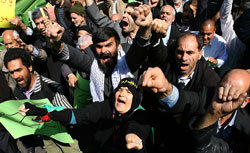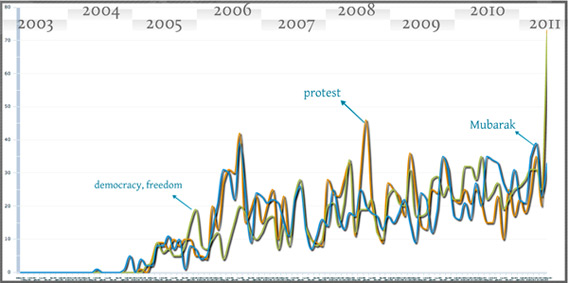
This article arises from Future Tense, a collaboration among Arizona State University, the New America Foundation, and Slate. A Future Tense event on how governments can use technology to streamline the foreign-aid process will be held at the New America Foundation headquarters on March 3. (For more information and to sign up for the event, please visit the NAF Web site.)
 Over the last several months, there has been seemingly endless discussion about how social media activisms have changed the political landscape of Egypt, Libya, Syria, Tunisia, and other countries in the Middle East and North Africa.
Over the last several months, there has been seemingly endless discussion about how social media activisms have changed the political landscape of Egypt, Libya, Syria, Tunisia, and other countries in the Middle East and North Africa.
But for all the headlines, there is very little research devoted to deepening our understanding of this phenomenon. A more thorough investigation on these movements in Egypt shows that the historical movement that happened in Tahrir Square was actually an imaginable surprise. It was tightly connected to the ongoing consolidation of disparate opposition groups and the expansion of online activism networks over time. To fully understand the Tahrir revolt, we need to look beyond January 2011, past the usage of Facebook and Twitter, and focus instead on how the protest networks emerged, expanded, and were translated into a momentous collective action?and how the Internet and social media became entangled in these processes. The social media activism in the recent mass protests is anchored in the burgeoning online activisms that have been happening in the region for years.
I would like to take you through the years preceding Egypt's revolution to demonstrate how years of technological innovation and social networking?online and off?laid the groundwork for Tahrir Square. The very genesis of online activism started in 2004 with the emergence of the Kefaya ("Enough") movement, followed by the emergence of oppositional activists in the Egyptian blogosphere.
Watch a 3-D timeline of the history of online activism in Egypt:
Kefaya: The Genesis
Built on the strands of the anti-Iraq-invasion protests in March 2003 held in Tahrir Square, Kefaya became the central force behind the first public demonstrations against President Mubarak. It was also the first oppositional nonpartisan coalitional movement without physical headquarters or permanent meeting place. Instead, one of Kefaya's major organizing spaces was Misr Digital, the first digital independent newspaper in Egypt. This Kefaya movement informed and inspired the emergence of youth activism online on Facebook and, after 2008, on Twitter.
Learning from the 2003 anti-Iraq-war protests, Kefaya made use of emails and text messages to mobilize. Kefaya published its campaigns online?to strategize around the control of the authorities?and propagated online banners and political cartoons on its website and through supporters' blogs. Kefaya also used digital images and videos to document state abuses and police brutality, disseminating them online through Flickr and YouTube. Kefaya made the connection between offline and online, from the Internet to the streets, routine.
The Growth of Egyptian Blogging
Beyond mobilization?campaigning, advertising, announcing, and reporting the movement and the scheduled protests?blogging enabled the inner circle of blogger/activists to deliberate on various important issues and contentions. It also allowed the creation of oppositional networks and for actors from different ideologies?e.g., leftists, liberals, Islamists?and backgrounds to connect.
While the number of Egyptian bloggers/activists increased significantly from 2005 to 2007, conversations and ideas were circulated only in a limited network. In the Kefaya era, there were only about 6 million Internet users in Egypt, or roughly 7 percent of the population. With such a limited network, Kefaya struggled to survive the government's intimidation, attacks, and abuses?including arrests on bloggers. Though Kefaya took advantage of regional and global media such as Al Jazeera, the movement's use of the limited Internet was not enough to fight against the state-controlled mainstream media. Despite being the most important model of dissent, Kefaya failed to reach beyond "an exclusive, Cairo-based intellectual crowd." High-minded bloggers focused on human rights and democracy, not the problems Egyptians faced on a daily basis. Kefaya also struggled with fragmentation and conflicts from within. By 2007, the movement was on the decline had been declined. The network, at that moment, was simply not big enough to make the mass revolt happen.
Though the influence of the movement itself waned, Kefaya's spirit of online activism endured. Its bloggers continued to communicate with one another and to post information online. As the increasingly repressive authorities deemed street protests illegal, and police brutalities dominated the Egyptian streets, the blogging network flourished. By mid-2009, the Egyptian blogosphere comprised the largest structural cluster of the Arabic blogosphere.

Photograph of Iranian protest by Atta Kenare/AFP/Getty Images.
Source: http://feeds.slate.com/click.phdo?i=4f2e457fb0d22cd22b43d5c5afac6cf1
mount rushmore evangeline lilly rbc bank amy winehouse weather the weather channel trial
No comments:
Post a Comment
Note: Only a member of this blog may post a comment.